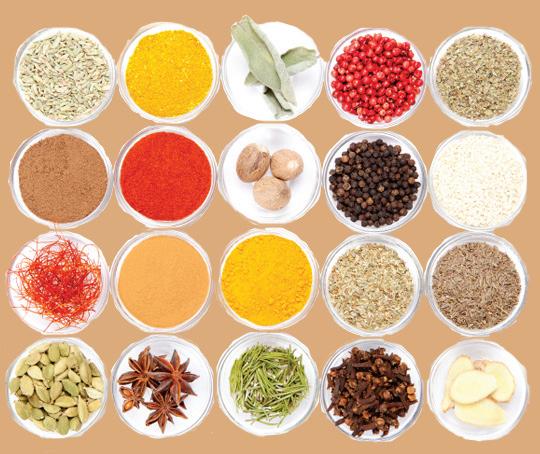
3 minute read
Spices & Seasonings
INTRODUCTION
Th e addition of spices and seasonings to a long-term food storage program is to enhance palatability and edibility of food storage commodities. Th ese ingredients added to cooking and baking allow us the option of variety and keeps food from being dull and mundane.
Advertisement
Spices are dried seeds, fruit, roots, or bark of plants that are used for fl avoring or coloring foods. Herbs are considered leafy parts of plants used for the same purpose (What’s Cooking, n.d.). Most spices and herbs contain essential oils that are responsible for the fantastic fl avors and aromas they provide. Spices are considered a comfort food with respect to an emergency food supply. Th ey are certainly not a priority, but they can add needed fl avors and colors to foods during a longterm emergency replicating the foods cooked on a daily basis.
Two of the most basic seasonings are salt and pepper. Salt is not only used to enhance fl avor, but in the case of yeast products, a necessary ingredient to help in proper dough formation.
QUALITY & PURCHASE
Purchase plain iodized salt for long-term storage. Spices and herbs are available in several forms: fresh, whole dried, or dried and ground. Only dried spices are used in emergency food storage. Purchase commercial grade spice at the grocery store. Keep in mind that spices on sale are oft en already old. Some spices can be stored in oil, but these products should be commercially purchased or be dried spices or herbs added to oils. Fresh spices or herbs added to oils may be a risk for botulism. Spices or herbs can be purchased as single varieties or blends. Generally screw-cap containers are better than fl ip tops because they have a tighter seal (Spice Barn, 2009). Exotic seasonings are available at most international markets or can be ordered online.


PACKAGING
Th e majority of the active components of spices and herbs are plant oils. And as oils, they can oxidize to lose fl avor and color. Th us, spices and herbs should be stored in air tight containers, such as jars or Mylar®™-type foil bags. Oft en the entire spice container can be sealed in jars or foil lined bags. Oxygen absorbers should be used to remove oxygen and prevent oxidation.
STORAGE CONDITIONS & SHELF LIFE
Th e best place to store spices or herbs is the freezer. Frozen spices or herbs will last considerably longer than those cold or at room temperature provided they are packaged to prevent moisture intrusion. Storing spices or herbs in a hot place will signifi cantly shorten their quality shelf life. Expect to reduce shelf life by at least 50 percent in hot environments (e.g., garages or attics). Whole spices store best. Both ground spices and herbs
(whole or ground) have a much shorter shelf life. Ground spices are exposed to air and tend to lose their quality much faster than the whole variety. When possible, whole, intact seasoning should be purchased and crushed just prior to using. This is easily done with a mortar and pestle or everyday coffee grinder. Ground spices and herbs should be checked for freshness every year, at least once. If there is no apparent aroma then the seasoning should be replaced (Spice Barn, 2009).
Iodized salt and baking powder have an indefinite shelf life when kept free of moisture and contamination. Salt can absorb odors from the storage area, even through the packaging. Salt can be poured into a canning jar and sealed with oxygen absorbers.
NUTRITION
Table salt and seasoning salts will obviously contribute sodium to the diet.
ALLERGIES: Spices offer little nutritive value as a food source and allergies are generally rare. However, if they do occur they are usually fairly mild. Spices that cause the most reactions are mustard, coriander, caraway, fennel, paprika, and saffron. Less frequently do people react to onions, garlic, and chives (Foods Standards Agency, n.d.). The U.S. Food and Drug Administration does not regulate spices, meaning they often are not noted on food labels, making spices possibly the most difficult allergen to identify or avoid. According to rough estimates, spice allergy is responsible for 2 percent of food allergies. However it is underdiagnosed, particularly due to the lack of reliable allergy skin tests or blood tests (ACAAI, 2012).
USE FROM STORAGE
Stored spices should be used exactly the same as spice for regular meals. If stored for long periods some of the potency may have diminished and adding more of that spice may compensate. Once opened and exposed to air, use the spice quickly within 1 to 4 months.









